In This Issue:
by Karen Marks, TPWD Aquatic Education Manager
Have you heard the new buzzword “R3”? No, it’s not the three “R’s” you grew up with… Reading, wRiting and aRithmetic… in our world of outdoor recreation and parks, it stands for Recruitment, Retention and Reactivation of outdoor recreation participants. It’s the same thing we’ve been doing for years, but now it has a name, “R3”. TPWD and other Natural Resource agencies across the nation are creating strategic plans to guide and increase participation in outdoor recreation.
While our state fishing license sales have slightly increased, the sales have not kept pace with the population increase in Texas. The sales of fishing licenses, which support conservation, fish and habitat management, stocking, and education, are vital to the success of the agency and more importantly for the resource itself and the people who utilize it.
Whether they know it or not, people need a connection to nature. This is borne out by the volumes of research that has been conducted and many books that have been written about the importance of the connection of humans to nature. The list is long and includes names such as Aldo Leopold (A Sand County Almanac), Henry David Thoreau (Walden, on Life in the Woods); and more recently Richard Louv (The Nature Principle and Last Child in the Woods) and Wallace J Nichols (The Blue MInd).
The R3 strategy is based on the Outdoor Recreation Adoption Model (ORAM) that has three stages: Recruitment, Retention and Reactivation. All three stages require social support for a person to move along the progression of the model.
 What does it mean when someone describes themselves by saying, I am a golfer, or I am a baseball player, or I am a birder, or I am a camper, or I am a hunter or I am an angler? How did they become that “person”?
Did they have someone that introduced them to the activity? Did they have someone teach them how to do the activity? (Recruitment)
Did they decide, I really like this activity and want to keep doing it. (Retention)
Maybe they participated in the activity for a while, then stopped to go to school, raise a family, or focus on a career, now they are ready to start again. (Reactivation)
During all of these stages, the person also needs the social support of their family or friends to talk about and support their involvement in the activity.
As an Angler Education Instructor, you play an important role for all three stages. For more info, read TPWD’s R3 Strategic Plan.
As Baba Dioum's quote states, "In the end, we will conserve only what we love: we will love only what we understand, and we will understand only what we are taught."
Back to Top
by Chris Johnson, TPWD Angler Education Area Chief, Central Texas
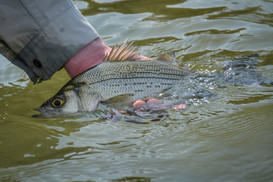
While Texas’ weather typically ignores the traditional four-season structure, springtime in the Lone Star State is truly magical. The redbuds begin to bloom, bluebonnets blanket the hill country, and migrating birds of all kinds begin to appear. All of these seasonal changes, while beautiful in their own right, are harbingers of the annual white bass spawning run.
White bass, commonly called sand bass or sandies, are a wonderful species to target on light tackle of all kinds. However, fly fishing is one of the most effective ways to target the species and arguably the most fun. Now, fly fishing is my profession so I will admit to being a bit biased. That being said, if you grab a fly rod when you head out to chase whites this season, I think you will agree with me!
Here are a couple of quick tips that will help you locate and catch more white bass on the fly this spring:
|
-
Location: White bass are present in reservoirs and rivers across the state. They swim upstream to spawn in the spring. Fish upstream of where a river enters a reservoir or immediately below a dam that impedes upstream migration. Fish will most often be concentrated in deeper pools below shallow riffles and shoals.
-
Line: Use a sinking line! A good friend of mine used to say, “Most fly anglers would rather eat dirt than cast a sinking line!” Many of the older sinking lines were cumbersome and not exactly pleasurable to fish. However, modern sinking lines are a blast to cast and there is no single item that will increase your catch rate more than a good sinking fly line. A sinking line keeps your fly in the strike zone longer which ultimately means more fish in your net!
-
Flies: Use a fly that rides hook point up! Clouser minnows, jigged streamer patterns, and many other general baitfish fly patterns are tied to ride hook point up. This keeps the fly from getting snagged as often, which as a result saves you money, time, and frustration!
-
Match the Hatch/Color - Duplicating forage is what fly fishing is all about! While white bass aren’t known for being particularly selective, learning to alter your fly color in certain conditions can help you seal the deal for springtime sandies! Think natural colors for clear water (gray, olive, white, tan, etc…) and use brighter or more contrasting colors for muddy water (chartreuse, brown, black, etc…). If the water is off color, you might think about adding some additional flash to your flies as well!
-
Leader/Tippet: Use fluorocarbon leader/tippet. Unlike nylon tippet and leader material, fluorocarbon sinks and is completely invisible underwater. Fluorocarbon also stretches less and is more abrasion resistant than other types of fishing line. These attributes help you keep your fly closer to the bottom, spook fewer fish in clear water, and will help you detect more strikes!
If you put these tips into practice, I think you will find a few more white bass on the end of your line this spring. In all my years of fly fishing, I still haven’t found anyone who regularly complains about catching more fish. For more information, check out my good friend, Pat Vanek’s presentation for TPWD on white bass. Enjoy your time on the water this spring and make sure that you take a little time to introduce someone new to the pleasure of fishing Texas!
(Photo by Chris Johnson)
Back to Top
by Jeremy Hancock, TPWD Angler Education Area Chief, Central Texas
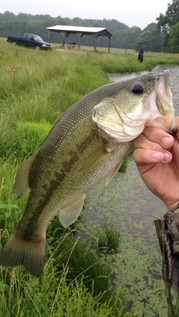
It may only be January, but winter is short here in Texas and before we know it, Spring will be here. With Spring, comes warmer weather, and the spawning season. As the water temperatures rise, bass will leave their winter hunting grounds and spend more time in shallower water under cover. This presents an opportune time for soft-plastic presentations.
With that comes the questions, what bait shape to throw, what color, or even what hook and weight you’ll rig it with. The number of options for anglers are these days higher than ever, but these 2 options could help lead to a successful day on the water.
Wacky-Rigged Stick Worm
Stick Worms are a common, popular bait for bass fishing. It can be rigged multiple ways, but for the purpose of this article, let’s go with a wacky-rig. It’s not best when needing a weedless situation or when you need to cover a lot of water, but very effective when bass are holding specific locations under cover. It’s a simple yet effective presentation. To “wacky-rig” a worm, run the hook through the center of the bait perpendicularly. It will create a natural and non-threatening presentation to the fish. Let the bait fall through the water until it hits the bottom, make upward twitches of the rod tip, letting the bait fall back to the bottom on the slackline. Target vertical cover (posts, logs, docks, etc) or drop offs or banks.
Soft Jerkbaits
Soft jerkbaits or Fluke baits can be a day saver when you’re struggling with other options. They are easily rigged weedless/weightless or can be fished Texas-rigged as well. When fished weedless/weightless, you can cover a lot of water quickly and that is sometimes the name of the game. It will also allow you to fish higher in the water column, using a “walk the dog” presentation. A Texas-rigged presentation gives you a weighted option that will allow you to fish in deeper water, over cover, etc. Try bumping a Texas-rigged fluke slower, like a falling bait to offer the fish a different presentation.
I hope these bait options and methods help you have a successful spawning season. These are 2 proven options, of many that can help you find success on the water. I will invite you to join an online class that I have scheduled on March 23rd. I will be making these 2 particular baits during the class giving a general overview on soft plastic bait making, also covering additional rigging options.
(Photo by Jeremy Hancock; Illustration by Clemente Guzman, TPWD)
|
 |
Back to Top
by Tim Birdsong, TPWD Chief of Habitat / Conservation, Inland Fisheries Division
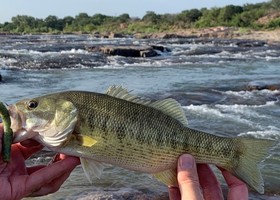
To catch a Guadalupe Bass Micropterus treculii, the official state freshwater fish of Texas, from one of the clear, spring-fed rivers of the Texas Hill Country should be on the bucket list of every Texan.
Guadalupe Bass are endemic to central Texas where populations are threatened with local extirpation from habitat degradation, flow alteration, and hybridization with non-native Smallmouth Bass Micropterus dolomieu. These threats are enormously challenging to address, but since concerted efforts to conserve the species were launched in 1991, Texas Parks and Wildlife Department (TPWD) and partners have restored or conserved Guadalupe Bass populations in 14 creeks and rivers. This was supported through a litany of conservation actions including conservation stocking of over 2.4 million genetically pure Guadalupe Bass, implementation of nearly 50 habitat restoration or preservation projects, and watershed-scale management of riparian invasive plants in eight watersheds.
Restoration of Guadalupe Bass populations is underway in another six rivers, while status assessments are planned for another eight rivers during 2021. TPWD currently manages 23 public river access areas that offer angling opportunities for Guadalupe Bass, which have served as focal points for engagement of fly fishing clubs, local conservation non-profits, and communities, in efforts to restore and preserve the species and its habitats. Although outcomes achieved for Guadalupe Bass represent an incredible conservation success story, continued actions are needed to ensure that current and future generations of Texas anglers are able to experience this storied fish.
To learn more about efforts to conserve Guadalupe Bass, check out TPWD’s annual report for the Guadalupe Bass Restoration Initiative.
(Photo by Tim Birdsong)
|
Back to Top
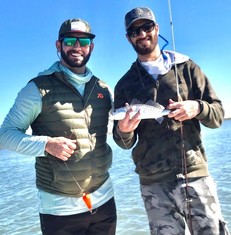
by Adam Comer, TPWD Aquatic Education Training Specialist
January 2022 is National Mentoring Month
The concept of mentoring is not new. Origins trace back to Homer’s epic, “The Odyssey”. In the poem, Odysseus knew he would be away fighting in the Trojan War for an extensive amount of time, so he placed Mentor, the son of Alcimus in Greek mythology, as his son’s guardian and advisor in his absence.
We believe this is the origin of the word, mentor.
Volunteering is grounded in helping and engaging others, so I don’t need to boldly proclaim its importance and impact. You know this. Instead, I want to share more info on ways to integrate mentoring into volunteering as an Angler Education Instructor.
First, what is mentoring? The American Psychological Association defines a mentor as an individual that provides a mentee with two primary functions: the activity-related function established the mentor as a coach, who provides advice to enhance the mentee’s ability with the activity, and the psychosocial function establishes the mentor as a role model and support system for the mentee.
|
Two main considerations when developing a mentor program is time and attention. Because mentoring includes time to build rapport, offer guidance and provide support, a one-time fishing event or class with a large teacher-to-student ratio, will most likely not allow for those robust interactions. Mentor programs have widely demonstrated positive societal impacts. One company’s mentor program found retention rates were much higher for mentees (72%) and mentors (69%), than for employees who did not participate in the mentoring program (49%) Source. The Outdoor Recreation Adoption Model depicted in the nationwide Recruitment, Retention and Reactivation program (R3) states that to develop lifelong outdoor enthusiasts, newcomers must have social support.
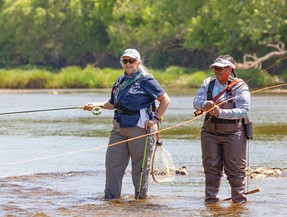
With support from various private and public partnerships, Texas Parks and Wildlife Dept. (TPWD) has continued to grow and expand outdoor mentoring programs like adult and youth Mentored Hunts on private and public lands. Programs to date include Texas Women’s Fly Fishers who provided a mentored outing with the Fishanistas, and an extensive mentoring program between TPWD Angler Education and the Texas Parks and Wildlife Foundation “Stewards of the Wild” Program. Beginning in the fall of 2020, the Foundation’s Mentored Fishing Program completed five weekend-long immersive programs, combining current Angler Ed Instructors and newly certified instructors in Stewards of the Wild from across the state, to mentor mentees that applied as a novice or beginning angler. Special attention was given to under-represented groups and veterans. The reviews are in, it’s been a huge success and we hope to continue to expand Angler Education mentoring opportunities.
TPWD Angler Education encourages volunteers to reach out to others, and mentor small groups whether recruiting, retaining, or reactivating them. Let us know if we can help!
|
Tips for a Successful Mentor Program:
- Strategic pairing – group mentees and mentors with similar personalities, locales, backgrounds, and values.
- Initiation phase – allow time to build rapport at the very beginning with more opportunity to socialize and teach a beginning/entry-level skill.
- Multiple touchpoints – build in ways to stay in touch outside of an event through social media, contact info, fishing club, etc. Schedule regular times to fish together.
- Be a mentee – continue to grow, learn, and experience from both “sides.”
(Top photo: Texas Parks and Wildlife Foundation mentored fishing event, by Ben Meadows. Bottom photo: Texas Women's Fly Fishers & Fishanistas mentored fishing event, by TPWD staff.)
Back to Top
by Michael Scherer, TPWD Angler Education Area Chief - Houston/Gulf Coast region
Volunteers often have great ideas for improving teaching tools and activities. Listen, learn, and make changes to improve your teaching gear. Also, be sure to share the great ideas!
Keiko Davidson, a TPWD Angler Instructor from the Katy area and Fishing's Future Katy Chapter member, asked if we could make the fish pictures a little larger on the back side of the backyard bass game. Since she is a retired principal from Katy ISD we figured she knew best.
Backyard Bass (BYB) are plastic fish that can be used to help students and families with their fishing skills. Students can learn to cast towards an object, catch, retrieve, and then view a picture, or answer a question - depending on the BYB fish set that you have created and are using.
We teach fish identification using a BYB set (with fish images taped on the back) most of the time. The request for the larger picture was to help students see the various fish identification marks when student use and follow the Angler Education dichotomous key made specifically for use with BYB. The key helps students and families identify the fish species using key traits (just like a biologist); the key also helps them learn more about the particular fish species. Using the fish picture on the bottom of the BYB fish to answer the dichotomous key questions is just one way to help teach fish ID to families new to fishing. If you include a length number on the BYB, then they can look up the regulations and any special rules for that species to determine if it's a keeper or if it should be released.
Since we own our BYB set, we decided to draw identification markings on the top of the BYB (please don't do this with borrowed equipment.) Instructors drew the black lines of a sheepshead, the whiskers of the catfish, and the tail fin dot of the red drum. These are just some of the fun and easy ways to combine fish ID and casting skills.
Make your educational gear fun, and keep the gear clean and in good working condition. And remember, when you work with your volunteers, listen to what they say! They are the KEY element to your programs, and they may have some great ideas.
(Photo by Fishing's Future volunteers.)
Back to Top
by Karen Marks, TPWD Aquatic Education Manager
Happy New Year! It’s a new calendar year, but for those of us in state government, we are already half-way through the 2nd quarter of the 2022 Fiscal year which runs September through August. Time flies!
Speaking of time flying by… 30 years ago the TPWD Aquatic/Angler Education program o-fish-ally started! And this summer, we will be conducting our 20th annual Area Chief Training Meeting. At this time, we are planning to conduct training in person at a place on the Highland Lakes (Central Texas) that has private or semi-private lodging and will afford a Covid-safe space. TWO people from the small original training held at TPWD Headquarters in Austin are still active with our program today, they are Larry Hysmith and Peggy York!
For those Area Chiefs that were certified more than 10 years ago, we have updated their certification to a “Legacy” status. If you are interested in becoming an Area Chief (Train-the-Trainer), and meet the minimum qualifications, please reach out to your regional training specialist (Greg Akins, Keira Quam or Adam Comer) and express your interest. The minimum qualifications include conducting at least one class/event as “Lead” and documentation of a minimum of 25 volunteer hours during the past year.
By now you should have received an incentive package in the mail if you were active and reported this past (fiscal) year. Despite the ongoing pandemic, we had a reasonable year – take a look at the annual report on the Accomplishment’s webpage. Twenty-two people earned their “100-hour” pin! We appreciate all who submitted timely reports, especially those who are teachers – we know that this past academic year has been exceptionally challenging for you. At the same time, we respect and honor those Instructors who are unable to serve during the pandemic.
As we announced in the Summer issue, all of our supply order and report forms have been updated – please be sure to use the current forms found on the Instructor Resources web page. While online class and event reports are preferred, we still accept hard copy reports via email or snail mail – just be sure they are filled out correctly. Unfortunately, 3% of the reports submitted this past fiscal year did not meet audit standards – while we are pleased that the percentage rate is low, it still means that we had to eliminate 375 volunteer hours, an equivalent of a $9,000 match for our federal aid grant. The most common errors were: 1) hours for multiple days were not itemized by date; 2) missing signatures on hard copies; and 3) event leaders wrote in the hours for the assistant volunteers on hard copies.
We really appreciate everyone’s efforts to report on time and accurately. When you report online, it helps staff to be more efficient. Our program would not be a success without YOU! Be sure to use the new email address, AnglerEdu@tpwd.texas.gov to submit supply orders and hard copy reports.
We are in the process of launching a School Pilot Tackle Loaner Program that will provide a basic fishing kit and tackle to Title 1 (K-12) schools and college campuses that are designated as a Historically Black College or University or a Hispanic Serving Institution. We plan to start with nine campuses (3 in each of the larger metro areas of Houston, Dallas/Fort Worth and Austin/San Antonio). The goal is to encourage families and young adults to explore the leisure recreation sport of fishing and hopefully create a lifelong recreation hobby. All of you play a role in this process, now known as “R3” ~ “Recruitment, Retention and Reactivation” of outdoor recreation participants. Read more about “R3” in the article above. (Photo credit: Chase Fountain, TPWD)
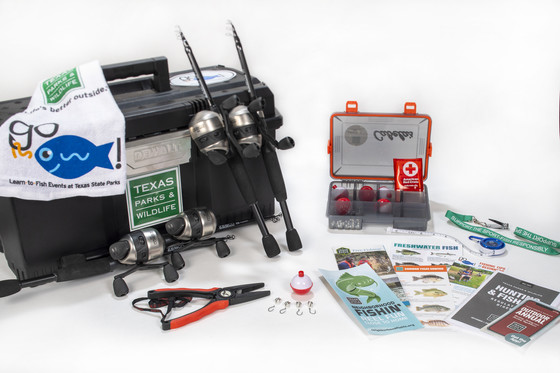 Back to Top
 (Photo taken during Instructor training workshop with Oscar Castillo)
TPWD Staff and Area Chiefs (volunteer Train-the-Trainers) trained 181 new instructors from July to December 2021. Go to the website to check out the list and welcome our New Instructors!
If you're an Area Chief and interested in learning to teach certification workshops online, contact TPWD Angler Ed staff for more information.
Remember if you are ordering literature or turning in paper reports to use our NEW email address!
Back to Top
Angler Education Program | Texas Angler Educators Facebook
Learn to Fish Videos | Texas Aquatic Science | TPWD Fishing Information
Volunteer Portal | In Memoriam | Staff Contacts
Angler Education Instructor Workshops, Fishing Events, Fly Fishing Events, Texas Freshwater Fisheries Center, Sea Center Texas
|